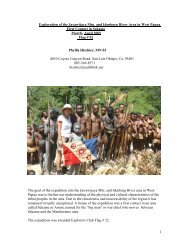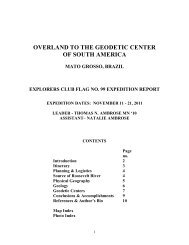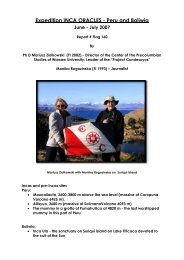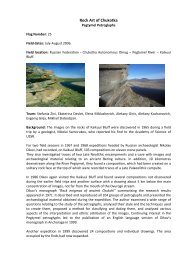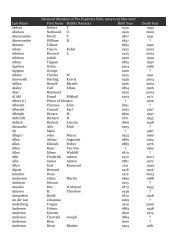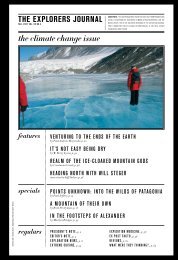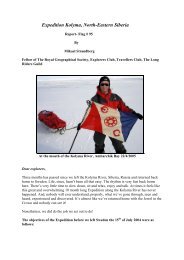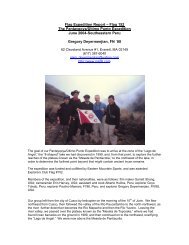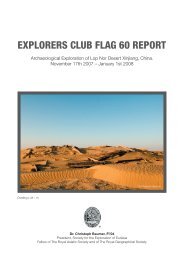the explorers journal - The Explorers Club
the explorers journal - The Explorers Club
the explorers journal - The Explorers Club
You also want an ePaper? Increase the reach of your titles
YUMPU automatically turns print PDFs into web optimized ePapers that Google loves.
elentless eruptions of magma and steam. We<br />
have found aqueous silicates around what may<br />
have been hot springs of volcanic fumaroles. At<br />
a place we call “Home Plate,” a circular feature in<br />
<strong>the</strong> Inner Basin of <strong>the</strong> Columbia Hills, Spirit found<br />
a collection of layered pyroclastic deposits (coarse<br />
grains lying beneath much finer material) which<br />
fits <strong>the</strong> pattern of accumulation of material raining<br />
down during a volcanic eruption. In contrast to <strong>the</strong><br />
steamy and violent environment encountered by<br />
Spirit, Opportunity, working halfway around <strong>the</strong><br />
planet, has found evidence of a wetter environment<br />
where acidic water once saturated <strong>the</strong> ground and<br />
occasionally flowed across its surface.<br />
EJ: So where are <strong>the</strong> rovers now<br />
SS: In April 2009—some 800 Sols, or Martian days,<br />
into <strong>the</strong> project and with more than 7.5 kilometers<br />
traveled—Spirit became trapped in deep, soft sand<br />
on <strong>the</strong> west side of Home Plate, eventually losing<br />
use of its right front wheel and right rear wheel in<br />
an attempt to free itself. After multiple attempts to<br />
dislodge <strong>the</strong> rover, we have decided for now to<br />
focus on experiments that will tell us information<br />
about its current location. As it turns out <strong>the</strong> “sand<br />
trap,” which we have nicknamed “Troy,” happens<br />
to be an excellent site for research purposes.<br />
Already, this has begun to yield interesting results.<br />
Just below <strong>the</strong> surface, <strong>the</strong> rover has found<br />
sulfate-rich deposits beneath its left wheels, which<br />
we believe were formed in steam vents associated<br />
with water-charged explosive volcanism. Spirit<br />
is sitting on <strong>the</strong> edge of a small crater, astride a<br />
boundary between crusty sulfate-rich deposits<br />
and soils with an average concentration of sulfur.<br />
We are also hoping that, from its stationary position,<br />
we can use radio tracking of Spirit to monitor<br />
any wobble in <strong>the</strong> planet’s axis of rotation, which<br />
could tell us whe<strong>the</strong>r Mars’ core is molten or solid.<br />
<strong>The</strong> biggest problem we face with Spirit now is<br />
that winter is setting in <strong>the</strong> sou<strong>the</strong>rn hemisphere<br />
and <strong>the</strong> rover’s solar array is tilted 9 degrees to<br />
<strong>the</strong> south, away from <strong>the</strong> Sun, ra<strong>the</strong>r than to <strong>the</strong><br />
north—as it would be if <strong>the</strong> rover were mobile—limiting<br />
its solar power supply. Spirit will go semi-dormant<br />
for <strong>the</strong> remainder of <strong>the</strong> Martian winter until<br />
<strong>the</strong> rover begins receiving enough solar power to<br />
recharge and resume operations.<br />
Opportunity, on <strong>the</strong> o<strong>the</strong>r hand, has just<br />
wrapped up operations at <strong>the</strong> Victoria Crater<br />
some 19 kilometers from its landing site and is<br />
now en route to Endeavour Crater, 11 kilometers<br />
away. <strong>The</strong> craters, by <strong>the</strong> way, are named in honor<br />
of great ships of discovery. During <strong>the</strong> traverse,<br />
<strong>the</strong> rover has encountered several interesting features<br />
on <strong>the</strong> o<strong>the</strong>rwise barren plain. One, which<br />
we dubbed Marquette Island, is a strange basaltic<br />
rock about <strong>the</strong> size of a basketball that appears<br />
to have come from deep in <strong>the</strong> Martian crust. We<br />
think it is ejecta from a distant crater. <strong>The</strong> rover<br />
also found two iron-rich meteorites of a type we<br />
find on Earth, which we named Block Island and<br />
Shelter Island. En route, we are having <strong>the</strong> rover<br />
investigate Concepción Crater, a small, young<br />
crater from a more recent impact.<br />
Opportunity’s probe of <strong>the</strong> craters within <strong>the</strong><br />
Meridiani Planum has revealed that surface waters<br />
evaporated <strong>the</strong>re, leaving behind sulfate-rich<br />
sands that, over time, have been shaped by wind<br />
and solidified by groundwater.<br />
EJ: Tell us about <strong>the</strong> Mars Reconnaissance<br />
Orbiter (MRO), which recently spied depressions—thought<br />
to be lakes—with drainage patterns<br />
consistent with flowing water near <strong>the</strong> Ares Vallis,<br />
a great gorge that runs along <strong>the</strong> Martian equator.<br />
SS: From <strong>the</strong> information we have from <strong>the</strong> rovers,<br />
it seems clear that water of some sort once flowed<br />
across <strong>the</strong> Martian landscape. <strong>The</strong> new images<br />
seem to confirm that. <strong>The</strong> relationship is synergistic<br />
between <strong>the</strong> rovers and <strong>the</strong> MRO, which<br />
provides a global view of <strong>the</strong> planet versus <strong>the</strong><br />
detailed inspection we gain on <strong>the</strong> ground. Each<br />
informs <strong>the</strong> movements and operations of <strong>the</strong> o<strong>the</strong>rs.<br />
<strong>The</strong> MRO is a key component of rover planning<br />
activity. MRO will see something that may<br />
be worth a rover look. Also, MRO’s companion<br />
orbiter Odyssey provides an important communications<br />
relay between Earth-based operations<br />
and <strong>the</strong> rovers at times when <strong>the</strong>ir locations are<br />
on <strong>the</strong> far side of <strong>the</strong> planet from Earth.<br />
EJ: What are your future plans for <strong>the</strong> project<br />
SS: In addition to continuing to use <strong>the</strong> rovers as<br />
long as <strong>the</strong>y remain in service, we are also working<br />
on <strong>the</strong> Mars Science Laboratory, which is somewhat<br />
more robust than Spirit and Opportunity.<br />
More than twice as large as <strong>the</strong> current rovers,<br />
it will collect Martian soil and rock samples and<br />
analyze <strong>the</strong>m for organic compounds that might<br />
attest life of some sort. For more on <strong>the</strong> state of<br />
affairs on Mars, visit: mars.nasa.gov<br />
<strong>the</strong> <strong>explorers</strong> <strong>journal</strong>



